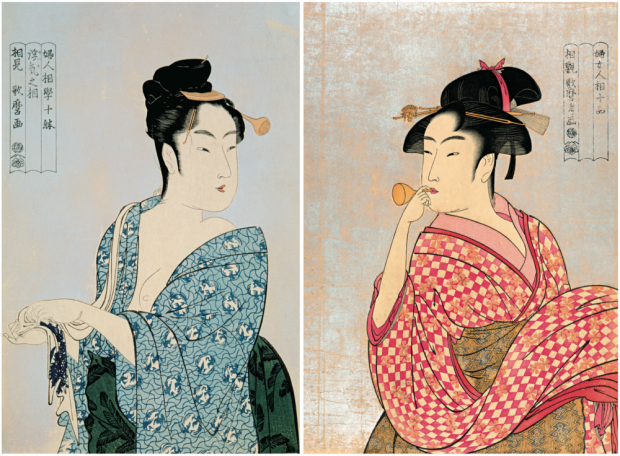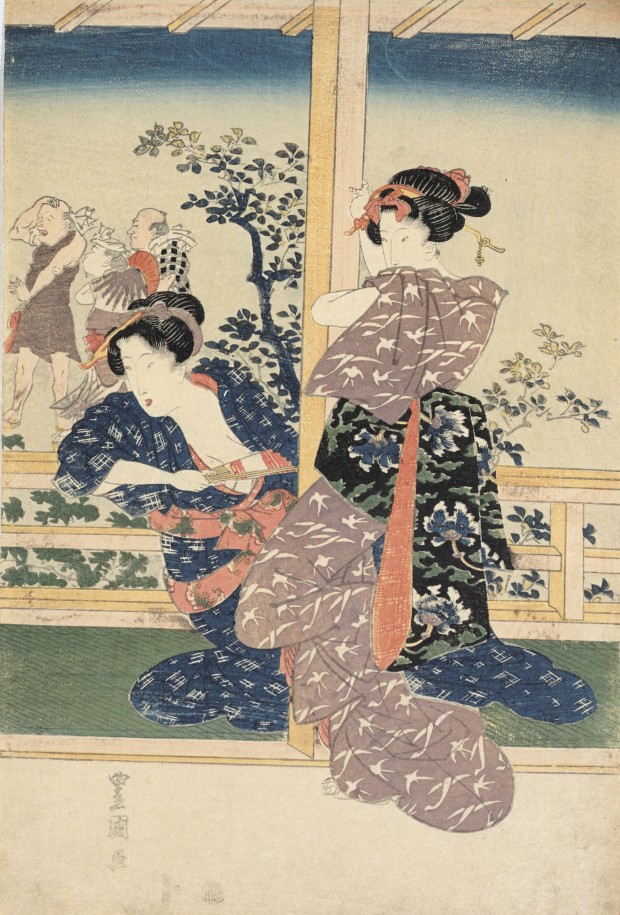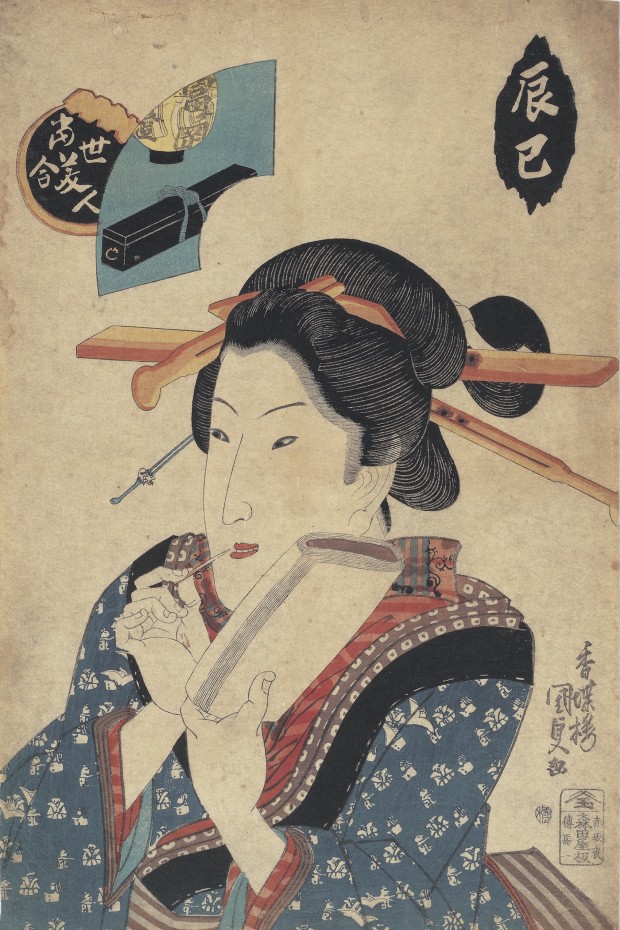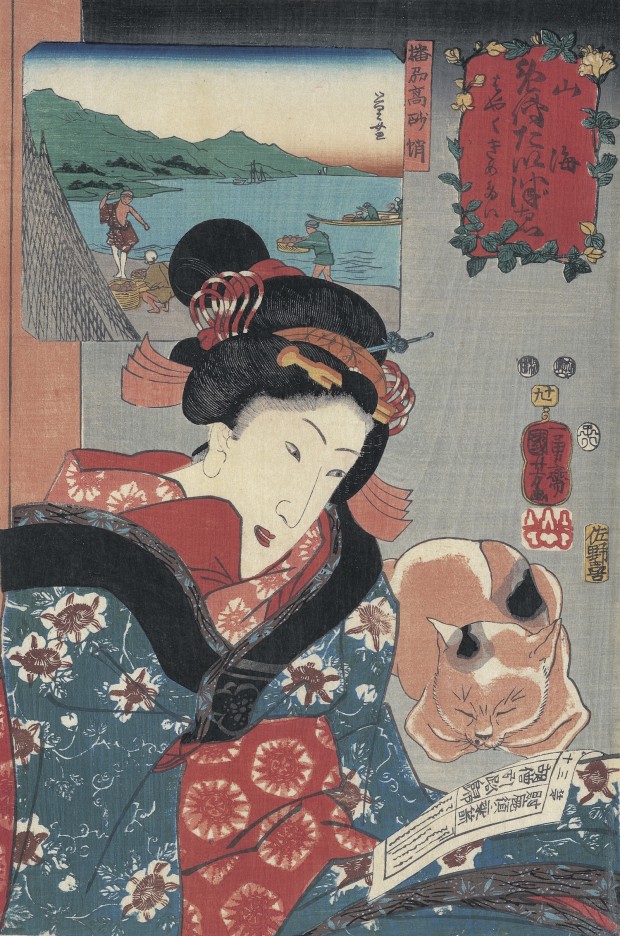Japanese woodblock print beauties
When it comes to Japanese art, what do you imagine? A genre called 浮世絵 (ukiyo-e) comprised of “pictures of the floating world,” in other words, artworks like woodblock prints of old Tokyo life and culture, serve as a popular and familiar example for many, especially those outside of Japan. Among the various themes included in ukiyo-e are images of beautiful women. Perhaps the king of this genre is an artist by the name of 喜多川歌麿 (Kitagawa Utamaro, c.1753-1806).
 Kitagawa Utamaro’s Ten Types in the Physiologic Study of Women series, large nishiki-e brocade picture with mica-powder background. (Left) “The Fickle Type,” c.1792-1793. Image: Tanaka Machio (PPS) (Right) “Young Woman Blowing a Poppin,” c.1789-1801. Image: Alamy(PPS)
Kitagawa Utamaro’s Ten Types in the Physiologic Study of Women series, large nishiki-e brocade picture with mica-powder background. (Left) “The Fickle Type,” c.1792-1793. Image: Tanaka Machio (PPS) (Right) “Young Woman Blowing a Poppin,” c.1789-1801. Image: Alamy(PPS)
Previously, we traced the evolution of beautiful women portraits in ukiyo-e, starting with the father of ukiyo-e, 菱川師宣(Hishikawa Moronobu, 1618-1694) and leading up to Kitagawa Utamaro’s time, as well as compared Utamaro works with those of other famed artists. Utamaro greatly expanded the realm of women’s images in woodblock prints with his pioneering of the 大首絵 (okubi-e, “large head,” bust-style portrait) format, as well as superb printing techniques to enhance both the character of his subjects and sumptuous details of their clothes and hair. As you can see below, this method of portraying subjects clearly became fashionable among Utamaro’s contemporaries and other artists who followed.
Let’s continue our exploration and look at Utamaro’s impact on other Japanese painters of beautiful women who came after the great master.
Strong characters make a strong impression
After Utamaro, the Edo period (1603-1868) started moving toward its close, while the techniques and styles of ukiyo-e also reached greater maturity. During this phase, the large Utagawa school of ukiyo-e also took shape. Its leader was 歌川豊国 (Utagawa Toyokuni, 1769-1825), who could bring his strengths to any of the genres. When depicting lovely women, he could draw on the styles of Kiyonaga, Eishi, and Utamaro to win popularity for his familiar and identifiable depictions of women. He also trained a large number of students in his techniques.
Utagawa Toyokuni, “The Cool of the Garden”
 Single panel of a large nishiki-e brocade triptych, c. 1822-1825, Yamaguchi Prefectural Hagi Uragami Museum.
Single panel of a large nishiki-e brocade triptych, c. 1822-1825, Yamaguchi Prefectural Hagi Uragami Museum.
As leader of the Utagawa school, Toyokuni had a bright, sociable, magnanimous personality, and the women he drew somehow seemed to be insistent, take-charge types. The familiarity he conveyed in his drawings seemed to be the secret of his popularity with the masses of Edo (1603-1868, present day Tokyo).
A sense of luxury
First among his students was 歌川国貞 (Utagawa Kunisada, 1786-1865). With the relaxation of official restrictions on ukiyo-e, Kunisada produced sumptuous pictures of beautiful women drawing on techniques borrowed from printing and carving.
Utagawa Kunisada, Contest of Present-day Beauties: “Southeast (Tatsumi)”
 Large nishiki-e brocade picture, c. 1828-1829, Yamaguchi Prefectural Hagi Uragami Museum.
Large nishiki-e brocade picture, c. 1828-1829, Yamaguchi Prefectural Hagi Uragami Museum.
Kunisada was blessed with a great natural talent for drawing—“For beautiful women and large brocade pictures, Kunisada is number one,” was the general opinion at the time. He had a sharp eye, and one characteristic of his drawings of beautiful women was his lifelike depiction of the habits and customs of everyday life for a wide range of women.
Expressing women’s thoughts
Another great who appeared from the Utagawa school was the highly original ukiyo-e artist, 歌川国芳 (Utagawa Kuniyoshi, 1797-1861). Making a name for himself with drawings of fierce samurai warriors, he also demonstrated a special talent for appealing depictions of beautiful women, frequently showing girls from Edo’s residential and entertainment districts.
Utagawa Kuniyoshi, Auspicious Desires on Land and Sea: “Wanting to Decide Right Away / Octopus from Takasago in Harima Province”
 Large nishiki-e brocade picture, 1852, Yamaguchi Prefectural Hagi Uragami Museum.
Large nishiki-e brocade picture, 1852, Yamaguchi Prefectural Hagi Uragami Museum.
As a woman reads her fortune, the cat seated near her has its front paws tucked under itself in what was called an “incense-box” pose. Since an incense box was one of the items a new bride took with her to her husband’s home, the phrase in the title, “Wanting to Decide Right Away,” refers to getting married. Kuniyoshi frequently engaged in such cleverness in his drawings of women.
Each artist had their own vision in portraying these lovely women, all of which are equally fascinating in their own way, yet there is no denying Utamaro’s influence in the styles of later artists, too.












